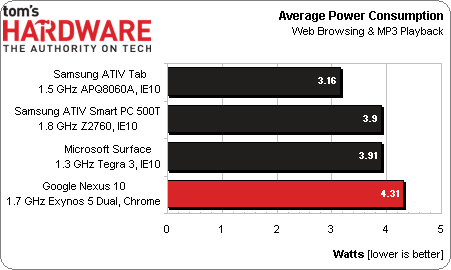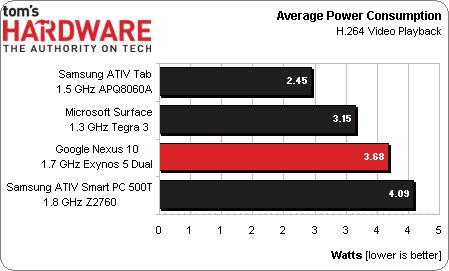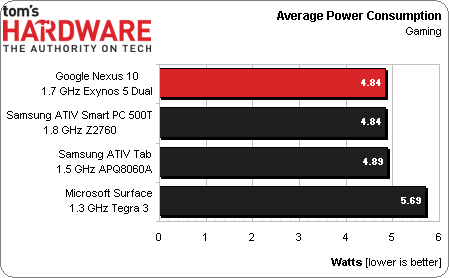Google Nexus 10 Review: Is 2560x1600 High-Def Enough?
Platform Power
We've been working with Intel to quantify the power that CPU cores, graphics engines, memory controllers, and LCD screens consume in specific and well-defined workloads. Intel's motivation is clear: it wants to (and has, we believe) shown that its x86 ISA competes readily against ARM-based devices when it comes to efficiency. And that's on a 32 nm process, even.
Our interest is a little more general, but no less intense. We want to be able to show how much power a given platform consumes when its idle, when it's juggling content consumption, and when it's gaming to show you that the tasks you perform on your tablet greatly influence how much battery life you can expect from it.
Now, on a Windows RT- or Windows 8-based setup, we're able to extend the desktop to an external display, shut off the tablet's screen, and measure power use without the LCD's impact, isolating the platform itself. But Android doesn't give us that flexibility. So, we either have to generate our numbers for the whole tablet, display included, or completely instrument the hardware and hook up leads to the right places, which we're still exploring. For now, these results are for complete tablet solutions.
In our Web browsing benchmark, which includes MP3 playback and a 200-nit calibrated display, the Nexus 10 exhibits the highest power use, confirming suspicions that Cortex-A15 is going to be more power-hungry than the -A9s in Nvidia's Tegra 3 under load. Qualcomm's Krait-based solution is the best-looking in this test, though we have to consider that we're not just looking at the SoC's performance.
At the same time, we know from Samsung ATIV Tab Review: A Tablet To Hold Your Breath For? that the APQ8060A demonstrates crazy-low power use when we bypass the ATIV Tab's display. That makes its commanding first-place finish in the video playback workload even more impressive. In contrast, the Nexus 10 uses slightly more power than Microsoft's Surface, but less than the Atom-based ATIV Smart PC 500T.
An easier workload gives the Nexus 10 an unfair advantage in this break-out of device power consumption in Riptide GP. Really, though, the only stand-out is Microsoft's Tegra 3-powered Surface, which uses quite a bit more power while it renders an enhanced version of the game.
Get Tom's Hardware's best news and in-depth reviews, straight to your inbox.
Current page: Platform Power
Prev Page Battery Life And Recharge Time Next Page Nexus 10: We Want To Love It, But Don't-
joytech22 The Nexus 10 is one of the most powerful Android devices available, but why?Reply
A T604 can be configured up to what - 8 cores? The Nexus 10 has ONE and it performs just under a PVR 543MP4
The CPU is absolutely monstrous, as is RAM Bandwidth, resolution etc..
I often think to myself - Why aren't other manufacturers sticking specs like these into their own systems? Stick a T604MP4 in there and you've got performance numbers (mind you, numbers likely not real-world) close to 2.5x that of the fastest iPad in every single way (except battery.. Lol).
As for CPU, Stick a 1.7GHz S4 Pro in there with 2GB of RAM and combine it with the same screen.
The company that does that has my next purchase guaranteed. -
killabanks as much as i love this tablet it needs a beefier gpu to handle that res just look what apple crammed in the ipad 4th genReply -
bit_user Why does the Color Temperature graph say "Higher is Better"? That's just wrong. The standard for accurate video reproduction is 6500 Kelvin.Reply
Values higher than that will result in the image having a blue bias. Values lower than that will result is the image appearing reddish. Of course, this also depends on the ambient light, which will influence how the image is perceived. But 6.5k Kelvin was supposedly chosen to match natural daylight.
-
neon neophyte i disagree completely about the screen analysis. it is most obvious on the picture of the blue flower. with the nexus 10 i can see all the detail in the pedals, the ipad is over saturated and has lost its detail.Reply -
killerclick There was an article a while ago that showcased Tom's Hardware writers and various devices they use. Almost all of them had an iPad or a Macbook or both.Reply
Just sayin'...
Link is http://www.tomshardware.com/picturestory/605-toms-hardware-editors.html -
bit_user neon neophytei disagree completely about the screen analysis. it is most obvious on the picture of the blue flower. with the nexus 10 i can see all the detail in the pedals, the ipad is over saturated and has lost its detail.Well, as they didn't say what camera they used or how it was configured, you have to assume they didn't disable AWB and that they used autofocus (which can have unpredictable results, when photographing a screen). Even if they avoided those two pitfalls, we don't know anything about the camera's spectral response function. Alone, that would be enough to disqualify any such comparison. Add to that the effects of your display device (I'll bet it's never been calibrated), and you should see that you really can't trust how these images show the respective screens.Reply
They also used images that are so vivid and almost artificial that it's sometimes hard to tell which display is reproducing the images more faithfully.
-
neon neophyte eh, they said in the article that we could see the difference in the pictures. then they went on to say those pictures reflected that the ipad was better.Reply
i disagree completely. -
bit_user neon neophyteeh, they said in the article that we could see the difference in the pictures. then they went on to say those pictures reflected that the ipad was better.i disagree completely.I'm not disagreeing with you. I'm just pointing out that their methodology seems badly flawed.Reply
If they want to learn how to write better video reviews, Tom's could do worse than to check out David Katzmaier's reviews, on CNet.
-
senshu neon neophyteeh, they said in the article that we could see the difference in the pictures. then they went on to say those pictures reflected that the ipad was better.i disagree completely.You're nowhere close to alone on this.Reply


